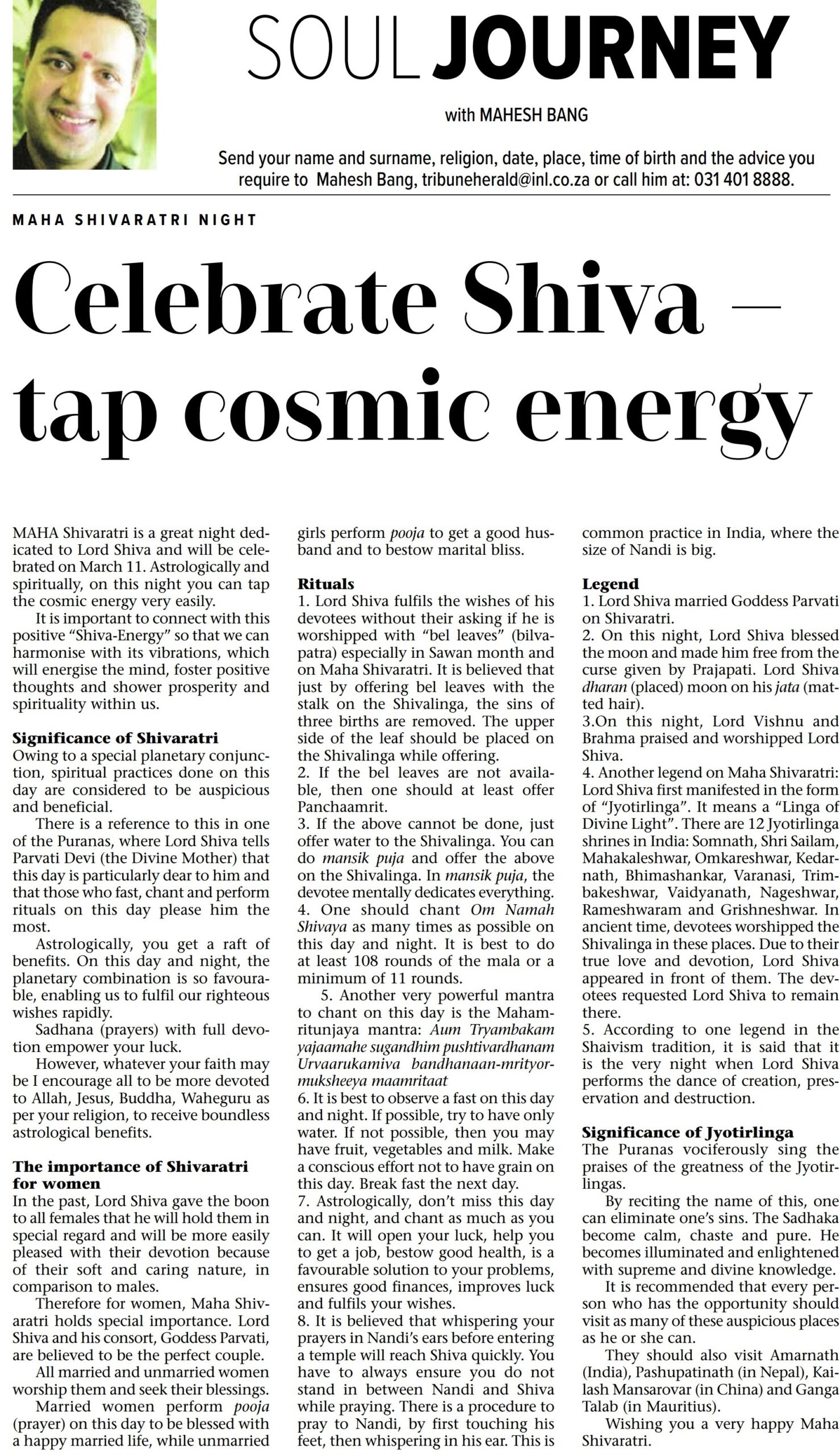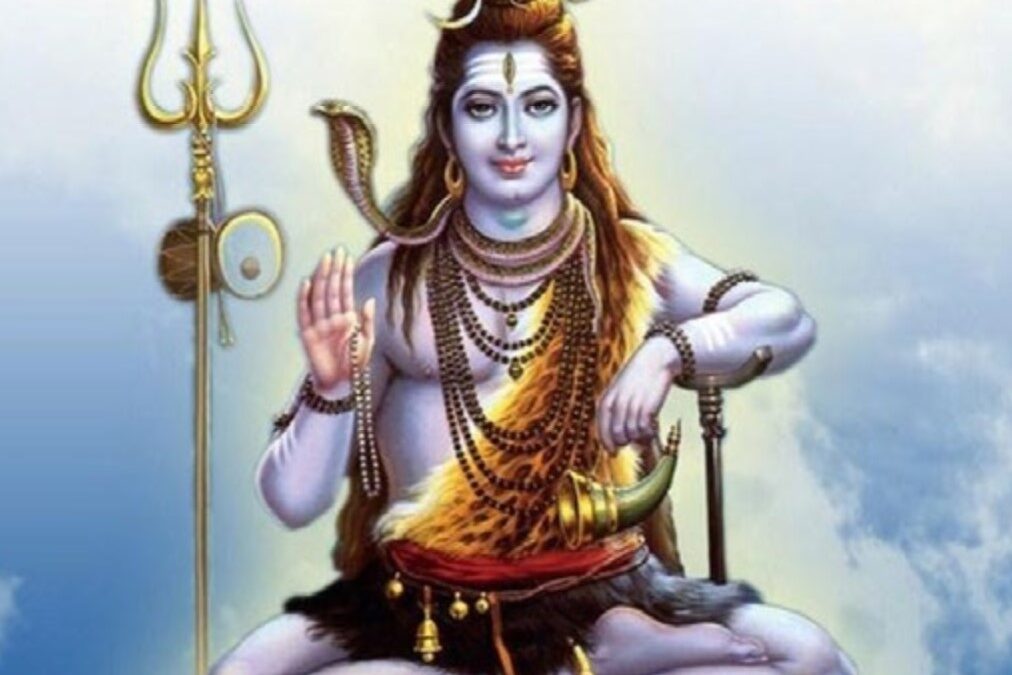
MAHA Shivaratri is a great night ded- icated to Lord Shiva and will be celebrated on March 11. Astrologically and spiritually, on this night you can tap the cosmic energy very easily.
It is important to connect with this positive “Shiva-Energy” so that we can harmonise with its vibrations, which will energise the mind, foster positive thoughts and shower prosperity and spirituality within us.
Significance of Shivaratri
Owing to a special planetary conjunction, spiritual practices done on this day are considered to be auspicious and beneficial.
There is a reference to this in one of the Puranas, where Lord Shiva tells Parvati Devi (the Divine Mother) that this day is particularly dear to him and that those who fast, chant and perform rituals on this day please him the most.
Astrologically, you get a raft of benefits. On this day and night, the planetary combination is so favourable, enabling us to fulfil our righteous wishes rapidly.
Sadhana (prayers) with full devotion empower your luck.
However, whatever your faith may be I encourage all to be more devoted to Allah, Jesus, Buddha, Waheguru as per your religion, to receive boundless astrological benefits.
The importance of Shivaratri for women
In the past, Lord Shiva gave the boon to all females that he will hold them in special regard and will be more easily pleased with their devotion because of their soft and caring nature, in comparison to males.
Therefore for women, Maha Shiv- aratri holds special importance. Lord Shiva and his consort, Goddess Parvati, are believed to be the perfect couple.
All married and unmarried women worship them and seek their blessings.
Married women perform pooja (prayer) on this day to be blessed with a happy married life, while unmarried girls perform pooja to get a good hus- band and to bestow marital bliss.
Rituals
- Lord Shiva fulfils the wishes of his devotees without their asking if he is worshipped with “bel leaves” (bilvapatra) especially in Sawan month and on Maha Shivaratri. It is believed that just by offering bel leaves with the stalk on the Shivalinga, the sins of three births are removed. The upper side of the leaf should be placed on the Shivalinga while offering.
- If the bel leaves are not available, then one should at least offer Panchaamrit.
- If the above cannot be done, just offer water to the Shivalinga. You can do mansik puja and offer the above on the Shivalinga. In mansik puja, the devotee mentally dedicates everything.
- One should chant Om Namah Shivaya as many times as possible on this day and night. It is best to do at least 108 rounds of the mala or a minimum of 11 rounds.
- Another very powerful mantra to chant on this day is the Mahamritunjaya mantra: Aum Tryambakam yajaamahe sugandhim pushtivardhanam Urvaarukamiva bandhanaan-mrityor- muksheeya maamritaat
- It is best to observe a fast on this day and night. If possible, try to have only water. If not possible, then you may have fruit, vegetables and milk. Make a conscious effort not to have grain on this day. Break fast the next day.
- Astrologically, don’t miss this day and night, and chant as much as you can. It will open your luck, help you to get a job, bestow good health, is a favourable solution to your problems, ensures good finances, improves luck and fulfils your wishes.
- It is believed that whispering your prayers in Nandi’s ears before entering a temple will reach Shiva quickly. You have to always ensure you do not stand in between Nandi and Shiva while praying. There is a procedure to pray to Nandi, by first touching his feet, then whispering in his ear. This is common practice in India, where the size of Nandi is big.
Legend
- Lord Shiva married Goddess Parvati on Shivaratri.
- On this night, Lord Shiva blessed the moon and made him free from the curse given by Prajapati. Lord Shiva dharan (placed) moon on his jata (mat- ted hair).
- On this night, Lord Vishnu and Brahma praised and worshipped Lord Shiva.
- Another legend on Maha Shivaratri: Lord Shiva first manifested in the form of “Jyotirlinga”. It means a “Linga of Divine Light”. There are 12 Jyotirlinga shrines in India: Somnath, Shri Sailam, Mahakaleshwar, Omkareshwar, Kedar- nath, Bhimashankar, Varanasi, Trim- bakeshwar, Vaidyanath, Nageshwar, Rameshwaram and Grishneshwar. In ancient time, devotees worshipped the Shivalinga in these places. Due to their true love and devotion, Lord Shiva appeared in front of them. The dev- otees requested Lord Shiva to remain there.
- According to one legend in the Shaivism tradition, it is said that it is the very night when Lord Shiva performs the dance of creation, pres- ervation and destruction.
Significance of Jyotirlinga
The Puranas vociferously sing the praises of the greatness of the Jyotir- lingas.
By reciting the name of this, one can eliminate one’s sins. The Sadhaka become calm, chaste and pure. He becomes illuminated and enlightened with supreme and divine knowledge.
It is recommended that every per- son who has the opportunity should visit as many of these auspicious places as he or she can.
They should also visit Amarnath (India), Pashupatinath (in Nepal), Kai- lash Mansarovar (in China) and Ganga Talab (in Mauritius).
Wishing you a very happy Maha Shivaratri.


